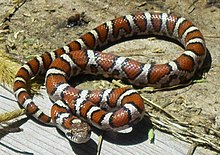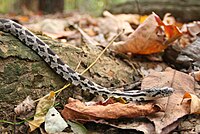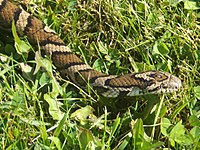Eastern milk snake
| Eastern milk snake | |
|---|---|

| |
| Adult eastern milk snake in Tennessee | |
| Scientific classification | |
| Kingdom: | Animalia |
| Phylum: | Chordata |
| Class: | Reptilia |
| Order: | Squamata |
| Suborder: | Serpentes |
| Family: | Colubridae |
| Genus: | Lampropeltis |
| Species: | |
| Subspecies: | L. t. triangulum
|
| Trinomial name | |
| Lampropeltis triangulum triangulum (Lacépède, 1789)
| |
| Synonyms[1][2] | |
| |
Lampropeltis triangulum triangulum, commonly known as the eastern milk snake or eastern milksnake, is a subspecies of Lampropeltis triangulum.[3] The nonvenomous, colubrid snake is indigenous to eastern and central North America.[4]
Geographic range[]
The eastern milk snake ranges from Maine to Ontario in the north to Alabama and North Carolina in the south.[4] It was once thought by herpetologists to intergrade with the scarlet kingsnake (Lampropeltis elapsoides) in a portion of its southern range, but this has been disproved.[5][6]
Common names[]
Additional common names for L. t. triangulum include the following: adder, blatschich schlange, chain snake, checkered adder, checkered snake, chequered adder, chequered snake, chicken snake, common milk snake, cow-sucker, highland adder, horn snake, house snake, king snake, leopard-spotted snake, milk sucker, pilot, red snake, sachem snake, sand-king, scarlet milk snake, spotted adder, and thunder-and-lightning snake.[2]
Description[]
The eastern milk snake averages 60 to 91 centimetres (24 to 36 in) in total length, although specimens as long as 132 centimetres (52 in) in total length have been measured. It has smooth and shiny scales. The dorsal color pattern consists of brownish dorsal saddles, which are edged with black. The dorsal saddles are sometimes reddish or reddish brown in southern areas of its range.[4][7] The pattern on the top and sides of the snake has also been described as three (or possibly five) series of black-bordered brown (reddish brown sometimes) blotches along the length of the snake on a gray or tan ground. The blotches in the dorsal series are large, while the blotches in the two (or possibly four) lateral series are smaller. The belly pattern is black and white checks (often irregular).[8]
As a pet[]
Like many species of milk snakes, the eastern milk snake is often bred in captivity for the pet trade. It is generally docile and rarely attempts to bite, though it may do so if feeling restrained.[citation needed]
Gallery[]

Juvenile eastern milk snake in Massachusetts

Eastern milk snake in Ohio

Eastern milk snake

Eastern milk snake at the Binder Park Zoo in Battle Creek, Michigan
References[]
- ^ "Lampropeltis triangulum ". The Reptile Database. www.reptile-database.org.
- ^ Jump up to: a b Wright, Albert Hazen; Wright, Anna Allen (1957). Handbook of Snakes of the United States and Canada. Ithaca and London: Comstock Publishing Associates, a division of Cornell University Press. 1,105 pp. (in 2 volumes). (Lampropeltis doliata triangulum, pp. 368-372, Figure 112 + Map 31 on p. 338).
- ^ Savitzky, Alan H. (2004). Hutchins, Michael; et al. (eds.). Grzimek's Animal Life Encyclopedia. 7: Reptiles, 2nd Edition. Detroit: Gale. p. 477. ISBN 978-0787657833.
- ^ Jump up to: a b c Mount, Robert H. (1975). The Reptiles and Amphibians of Alabama. Auburn, Alabama: Auburn Printing Company. pp. 200–201. OCLC 1958638.
- ^ Williams, Kenneth L. (1988). Systematics and Natural History of the American Milk Snake, Lampropeltis triangulum. Milwaukee, Wisconsin: Milwaukee Public Museum. ISBN 978-0893261580.
- ^ Armstrong, Michael P.; Frymire, David; Zimmerer, Edmund J. (December 2001). "Analysis of sympatric populations of Lampropeltis triangulum syspila and Lampropeltis triangulum elapsoides, in western Kentucky and adjacent Tennessee with relation to the taxonomic status of the scarlet kingsnake". Journal of Herpetology. 35 (4): 688–93. doi:10.2307/1565915. JSTOR 1565915.
- ^ Behler, John L.; King, F. Wayne (1979). The Audubon Society Field Guide to North American Reptiles and Amphibians. New York: Knopf. p. 457. ISBN 978-0394508245.
- ^ Conant, Roger; Collins, Joseph T. (1991). Reptiles and Amphibians. Peterson Field Guides. Boston: Houghton Mifflin. p. 207. ISBN 978-0395583890.
External links[]
| Wikimedia Commons has media related to Lampropeltis triangulum. |
- . Encyclopedia Americana. 1920.
Further reading[]
- Boulenger GA (1894). Catalogue of the Snakes in the British Museum (Natural History). Volume II., Containing the Conclusion of the Colubridæ Aglyphæ. London: Trustees of the British Museum (Natural History). (Taylor and Francis, printers). xi + 382 pp. + Plates I-XX. (Coronella triangulum, pp. 200–201).
- Conant R (1975). A Field Guide to Reptiles and Amphibians of Eastern and Central North America, Second Edition. The Peterson Field Guide Series. Boston: Houghton Miffflin. xviii + 429 pp. + Plates 1-48. ISBN 0-395-19979-4 (hardcover), ISBN 0-395-19977-8 (paperback). (Lampropeltis t. triangulum, pp. 204, 206 + Plate 30 + Map 153).
- Conant, Roger; Bridges, William (1939). What Snakes Is That? A Field Guide to the Snakes of the United States East of the Rocky Mountains. (With 108 drawings by Edmond Malnate). New York and London: D. Appleton-Century. Frontispiece map + 163 pp. + Plates A-C, 1-32. (Lampropeltis t. triangulum, pp. 80–81 + Plate 13, figure 37).
- Lacépède [BG] (1789). Histoire Naturelle des Quadrupèdes Ovipares et des Serpens. Tome Second [Volume 2]. Paris: Imprimerie du Roi, Hôtel de Thou. 671 pp. (Coluber triangulum, new species, table méthodique, pp. 86–87). (in French).
- Lacépède [BG] (1789). Histoire Naturelle des Quadrupèdes Ovipares et des Serpens. Tome Quatrième [Volume 4]. Paris: Saugrain. 386 pp. ("Couleuvre triangle ", p. 188). (in French).
- McCoy, C.J. (1980). Identification Guide to Pennsylvania Snakes. (Design and illustrations by Michael Antonoplos). Pittsburgh, Pennsylvania: Carnegie Museum of Natural History. 12 pp. (Lampropeltis triangulum, p. 8).
- Morris, Percy A. (1948). Boy's Book of Snakes: How to Recognize and Understand Them. New York: Ronald Press. (A volume of the Humanizing Science Series, edited by Jaques Cattell). viii + 185 pp. (Lampropeltis doliata triangulum, pp. 24–26, 180).
- Netting, M. Graham; Richmond, Neil D. (editors) (1970). Pennsylvania Reptiles and Amphibians. Third Edition, Fifth Printing. (Photographs by Hal H. Harrison). Harrisburg, Pennsylvania: Pennsylvania Fish Commission. 24 pp. (Lampropeltis doliata triangulum, p. 5).
- Powell R, Conant R, Collins JT (2016). Peterson Field Guide to Reptiles and Amphibians of Eastern and Central North America, Fourth Edition. Boston and New York: Houghton Mifflin Harcourt. xiv + 494 pp., 47 plates, 207 figures. ISBN 978-0-544-12997-9. (Lampropeltis triangulum, p. 381 + Plate 35 + Figure 159 on p. 330).
- Schmidt, Karl P.; Davis, D. Dwight (1941). Field Book of Snakes of the United States and Canada. New York: G.P. Putnam's Sons. 365 pp., 34 plates, 103 figures. (Lampropeltis t. triangulum, pp. 186–188, Figure 56 + Plates 5, 20).
- Smith, Hobart M.; Brodie, Edmund D., Jr. (1982). Reptiles of North America: A Guide to Field Identification. New York: Golden Press.240 pp. ISBN 0-307-47009-1 (hardcover), ISBN 0-307-13666-3 (paperback). (Lampropeltis t. triangulum, p. 180-181).
- Stejneger L, Barbour T (1917). A Check List of North American Amphibians and Reptiles. Cambridge, Massachusetts: Harvard University Press. 125 pp. (Lampropeltis t. triangulum, pp. 89–90).
- Lampropeltis
- Snakes of North America
- Reptiles of Canada
- Reptiles of the United States
- Fauna of the Eastern United States
- Taxa named by Bernard Germain de Lacépède



